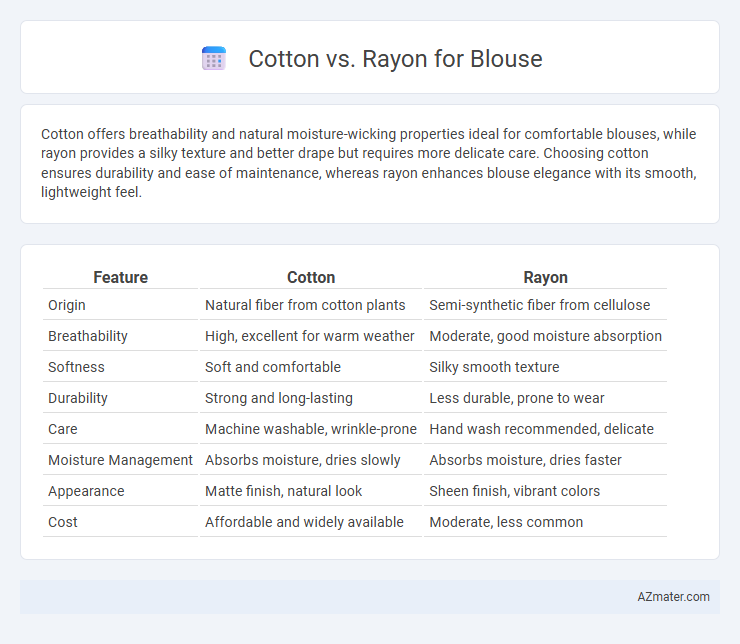Cotton offers breathability and natural moisture-wicking properties ideal for comfortable blouses, while rayon provides a silky texture and better drape but requires more delicate care. Choosing cotton ensures durability and ease of maintenance, whereas rayon enhances blouse elegance with its smooth, lightweight feel.
Table of Comparison
| Feature | Cotton | Rayon |
|---|---|---|
| Origin | Natural fiber from cotton plants | Semi-synthetic fiber from cellulose |
| Breathability | High, excellent for warm weather | Moderate, good moisture absorption |
| Softness | Soft and comfortable | Silky smooth texture |
| Durability | Strong and long-lasting | Less durable, prone to wear |
| Care | Machine washable, wrinkle-prone | Hand wash recommended, delicate |
| Moisture Management | Absorbs moisture, dries slowly | Absorbs moisture, dries faster |
| Appearance | Matte finish, natural look | Sheen finish, vibrant colors |
| Cost | Affordable and widely available | Moderate, less common |
Introduction to Cotton and Rayon for Blouses
Cotton, a natural fiber derived from the cotton plant, is prized for its breathability, softness, and durability, making it ideal for comfortable blouses that suit warm weather. Rayon, a semi-synthetic fiber made from regenerated cellulose, offers a silky texture and excellent drape, providing a lightweight and elegant option for stylish blouses. Both fibers serve different functional and aesthetic needs, influencing the choice based on desired comfort, appearance, and care requirements.
Fabric Origins: Cotton vs Rayon
Cotton fabric originates from the natural fibers of the cotton plant, known for its breathability, softness, and durability, making it ideal for everyday blouses. Rayon, a semi-synthetic fabric, is derived from cellulose fibers extracted from wood pulp, offering a smooth, silky texture that drapes well but requires delicate care. Understanding the natural origin of cotton versus the regenerated origin of rayon helps in choosing the right blouse fabric based on comfort and maintenance preferences.
Comfort and Wearability Comparison
Cotton blouses offer superior breathability and moisture absorption, making them highly comfortable for all-day wear, especially in warm climates. Rayon blouses provide a silky, smooth texture with a lightweight feel, but they tend to wrinkle easily and may require more delicate care to maintain wearability. Both fabrics are versatile, yet cotton excels in durability and ease of maintenance, while rayon delivers a softer touch and better drape.
Breathability and Moisture Management
Cotton blouses excel in breathability due to their natural fibers, allowing air to circulate and keeping the wearer cool in warm conditions. Rayon, while also breathable, offers superior moisture management by wicking sweat away from the skin and drying faster than cotton. Choosing between cotton and rayon for blouses depends on whether breathability or quick moisture evaporation is the priority in comfort and performance.
Durability and Longevity
Cotton blouses are known for their high durability and ability to withstand frequent washing without significant wear, making them ideal for long-term use. Rayon, although soft and comfortable, tends to be less durable as it can weaken and lose shape faster over time due to its semi-synthetic fiber composition. Choosing cotton ensures enhanced longevity and resistance to pilling and tearing compared to rayon blouses.
Maintenance and Care Requirements
Cotton blouses require regular washing and tend to shrink or wrinkle if not properly cared for, necessitating gentle machine cycles or hand washing and ironing at medium heat. Rayon blouses are more delicate, often needing hand washing or dry cleaning to prevent damage, and they dry quickly but may lose shape if stretched when wet. Proper care for each fabric extends the longevity and maintains the appearance of the blouse.
Environmental Impact: Cotton vs Rayon
Cotton cultivation requires significant water resources and often relies on pesticides, contributing to soil degradation and water pollution, while rayon production involves chemically intensive processes that can release harmful toxins if not managed properly. Organic cotton offers a more sustainable alternative with reduced environmental harm compared to conventional cotton, whereas lyocell, a type of rayon made through closed-loop processing, presents a greener option due to its biodegradability and lower chemical use. Choosing between cotton and rayon for blouses hinges on evaluating water consumption, chemical impact, and biodegradability to minimize ecological footprints.
Style and Aesthetic Appeal
Cotton blouses offer a natural, breathable fabric with a matte finish that provides a classic, casual, and timeless style suitable for everyday wear. Rayon blouses feature a silky, smooth texture with a slight sheen, creating a more elegant and drapey aesthetic that enhances formal or dressy looks. The choice between cotton and rayon impacts the blouse's overall appearance, with cotton emphasizing comfort and simplicity, while rayon highlights sophistication and fluidity.
Cost Considerations
Cotton blouses generally have a higher upfront cost due to natural fiber sourcing and durability, making them a long-term investment for breathable, comfortable wear. Rayon blouses tend to be more affordable initially but may require more frequent replacement because of their susceptibility to wear and shrinkage. Evaluating cotton and rayon costs involves weighing the balance between initial price and maintenance expenses over time.
Choosing the Best Fabric for Your Blouse
Cotton offers breathability, durability, and natural moisture-wicking properties, making it ideal for everyday blouse wear in warm climates. Rayon provides a silky texture and drapes elegantly but requires more delicate care to maintain its softness and shape. Selecting the best fabric depends on your lifestyle needs: choose cotton for comfort and longevity or rayon for a stylish, lightweight option that enhances sophistication.

Infographic: Cotton vs Rayon for Blouse
 azmater.com
azmater.com